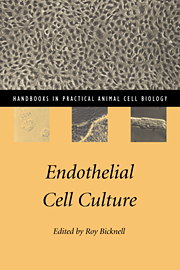Book contents
- Frontmatter
- Contents
- List of Contributors
- Preface to the series
- Acknowledgement
- 1 Introduction to the endothelial cell
- 2 Lung microvascular endothelial cells: defining in vitro models
- 3 Bone marrow endothelium
- 4 Endothelium of the brain
- 5 Isolation, culture and properties of microvessel endothelium from human breast adipose tissue
- 6 Human skin microvascular endothelial cells
- 7 Microvascular endothelium from adipose tissue
- 8 Endothelium of the female reproductive system
- 9 Synovial microvascular endothelial cell isolation and culture
- Index
6 - Human skin microvascular endothelial cells
Published online by Cambridge University Press: 03 November 2009
- Frontmatter
- Contents
- List of Contributors
- Preface to the series
- Acknowledgement
- 1 Introduction to the endothelial cell
- 2 Lung microvascular endothelial cells: defining in vitro models
- 3 Bone marrow endothelium
- 4 Endothelium of the brain
- 5 Isolation, culture and properties of microvessel endothelium from human breast adipose tissue
- 6 Human skin microvascular endothelial cells
- 7 Microvascular endothelium from adipose tissue
- 8 Endothelium of the female reproductive system
- 9 Synovial microvascular endothelial cell isolation and culture
- Index
Summary
Introduction
Local differentiation gives rise to remarkable endothelial heterogeneity in the vascular and lymphatic systems of different organs. Because of its strategic location, microvascular endothelium plays a central role in skin physiology, and its involvement in pathologies of the skin is becoming increasingly apparent. Thus, endothelial cells play a role in anti-thrombogenicity, blood vessel permeability, blood pressure control, metabolism of lipoproteins, tissue ageing, antigen presentation, and angiogenesis in wound healing. Dysfunctions are associated with a number of pathologies such as inflammation, immune disorders and hyperproliferation of vessels in, for example, psoriasis.
In vitro culture of endothelial cells from large vessels (aorta and umbilical vein) has provided a useful model for the study of endothelial cell metabolism; however, the validity of using endothelial cells isolated from the macrovasculature to study microvascular behaviour and function is questionable. Nearly 20 years ago, the group led by Karasek developed endothelial cell cultures derived from capillaries of rabbit skin (Davison & Karasek, 1978) and from the human newborn foreskin dermis. These established more representative in vitro models of the skin microvasculature (Davison et al, 1980). More recently, Davison et al. have also published a method for the isolation and long-term serial cultivation of endothelial cells derived from microvessels of the adult human dermis (Davison et al., 1983).
Cultured skin microvascular endothelial cells have a wide range of research applications including the study of cellular differentiation, cytokine expression, haemorrhagic disorders, hypersensitivity, inflammation, thrombogenesis and thrombosis, tumour metastasis, and wound healing. Because of a large reduction in toxicological tests involving laboratory animals, in vitro cell culture models are of increasing importance.
- Type
- Chapter
- Information
- Endothelial Cell Culture , pp. 77 - 90Publisher: Cambridge University PressPrint publication year: 1996
- 2
- Cited by



